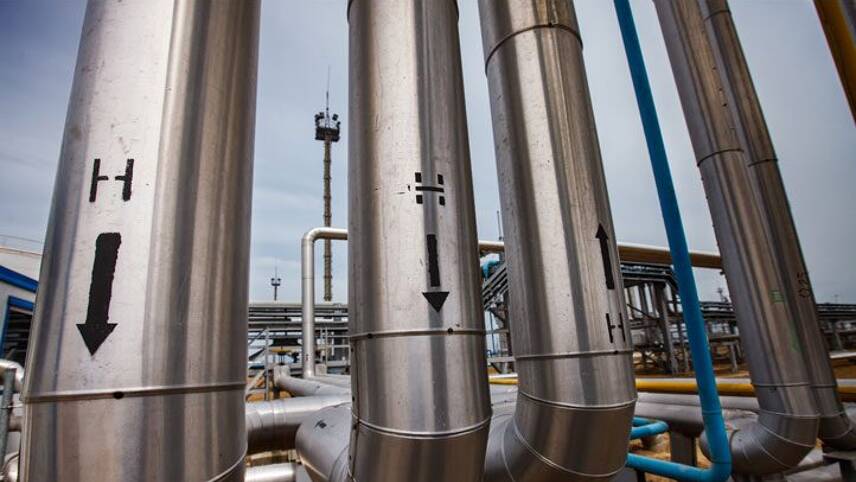Register for free and continue reading
Join our growing army of changemakers and get unlimited access to our premium content

Hydrogen pipes are seen at an oil refinery and gas processing plant in the Uralsk region
The vision document, outlined on Tuesday (13 April), is the updated version of a report presented last July, which envisioned a hydrogen pipeline network of 23,000 km covering 10 European countries: Belgium, Czech Republic, Denmark, France, Germany, Italy, the Netherlands, Spain, Sweden and Switzerland.
The updated version is now almost double in size, reaching 39,700 km by 2040, and connecting 21 European countries, including central and eastern Europe, the UK, Ireland, Greece and Nordic countries.
The key message is that “the existing gas infrastructure offers a technically and economically plausible” way of building a pure hydrogen network, said Daniel Muthmann, the coordinator of the European hydrogen backbone initiative.
According to its promoters, 69% of the proposed hydrogen backbone could consist of repurposed existing natural gas grids, keeping the overall cost of the infrastructure at relatively modest levels.
In total, the investment is estimated at between €43 billion and €81 billion by 2040, says the report prepared by consultancy firm Guidehouse and supported by 23 gas TSOs, including Italy’s Snam, France GRTgaz, Spain’s Enagas, and the Netherland’s Gasunie.
Compared to last year, the price per kilometre has even been revised downwards because the updated version takes into account that hydrogen infrastructure can consist of smaller pipelines, which are cheaper to repurpose.
The opportunity for Europe, Muthmann said, is to create “a liquid market for renewable and low-carbon hydrogen,” which can be used to decarbonise hard-to-abate industries like chemicals and steelmaking.
But developing a hydrogen market will require advance planning, he added, saying European policymakers “need to make decisions relatively quickly” on infrastructure in order to connect future supply and demand centres.
The vision document appears to be in line with the European Commission’s hydrogen strategy presented last year. In July, the EU executive outlined plans to produce up to 10 million tonnes of renewable hydrogen in the EU by 2030, based on 40 gigawatts of electrolysers.
To achieve this, the Commission said “planning of medium range and backbone transmission infrastructure should begin” right away in order to allow the emergence of “a liquid and well-functioning hydrogen market” in the next decade.
Speaking in May last year, the EU’s climate chief Frans Timmermans said the EU executive was looking at existing natural gas and liquefied natural gas (LNG) infrastructure to develop a hydrogen network.
“The more we can have dual use of infrastructure, the better it is – also to make the transition to green hydrogen affordable in the future,” Timmermans said. “I’m really excited by those possibilities and we will do a lot of work in that direction,” he added.
In countries like Poland, Czechia and Slovakia, hydrogen is seen as a key driver of plans to decarbonise coal-based regions. By 2040, the Czech Republic and Slovakia could become hydrogen hubs, said Daan Peters, one of the authors of the study at consultancy firm Guidehouse.
Across Europe, LNG terminals can be adapted to import green hydrogen produced from abundant solar energy resources in North Africa, the Middle East or Australia. “We can import from Norway, potentially even from Russia,” Peters said.
Elsewhere, in Baltic and Scandinavian countries, gas infrastructure offers the opportunity to store large quantities of green hydrogen produced from offshore wind.
“On very windy days, there is simply going to be too much wind” over and above electricity demand, said Kees van der Leun, director at Guidehouse. “Converting that wind into hydrogen would be a great option” to balance the electricity grid on less windy days, he said.
Potential caveats
Environmentalists are somewhat sceptical though, warning against the risk of developing an oversized infrastructure.
“Hydrogen infrastructure shouldn’t be an end in itself – if the goal is to use hydrogen as a piece of the EU climate neutrality puzzle, a clustered approach where supply and demand are geographically close may be the best option,” said Eleonora Moro, a researcher at climate think-tank E3G.
“This would minimise costs, the need for expensive retrofitting, and ensure that today’s gas consumers are not paying for tomorrow’s hydrogen users” who are not likely to be the same people, Mora said.
Last week, a study by think-tank Global Energy Monitor found that Europe is already building or planning to build €87 billion worth of fossil gas infrastructure in a continued expansion of pipelines and LNG terminals, despite the need to halve emissions by 2030.
According to the European Commission, gas demand is expected to be 25% lower by 2030 due the EU’s climate policies, increasing the odds that parts of Europe’s gas infrastructure will soon become stranded assets.
For European Greens, the risk is that Europe’s hydrogen strategy is used as an excuse to prop up the gas industry and subsidise obsolete gas pipelines.
“These are complex decisions that need to be made based on independent, science-based analysis to ensure hydrogen delivers for decarbonisation, rather than for the gas networks,” Mora said.
Frederic Simon, EurActiv.com
This article first appeared on EurActiv.com, an edie content partner. The original article was supported by the Fuel Cells and Hydrogen Joint Undertaking.


Please login or Register to leave a comment.